Will Pfeifer's Blog, page 31
July 8, 2013
Great Moments in Comics History, Part 26
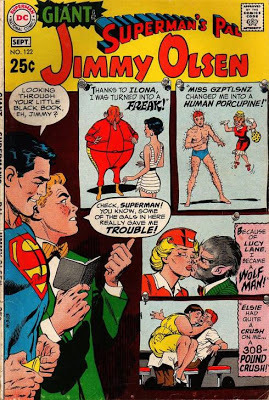
Jimmy Olsen turns into a freak so creepy (top left image) that it disturbed me for years, even though I only saw it in on a tiny cover reproduction (much smaller than seen here) in a DC house ad when I was a kid.
Superman's Pal Jimmy Olsen (Sept. 1969), pencils by Curt Swan, inks by Neal Adams
Published on July 08, 2013 18:01
June 29, 2013
Movies I watched in June
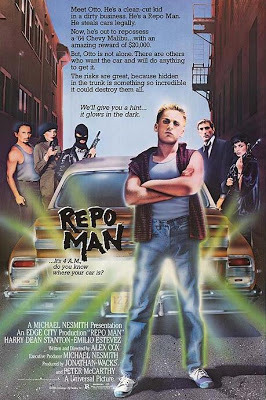
Watching the new Criterion Blu-ray of this cult classic made me realize that this really is one of the truly great movies of the 1980s. Soundtrack, story, cast, dialogue and use of those vintage Los Angeles locations make it a truly unique viewing experience. Writer/director Alex Cox manages to take all sorts of disparate elements, like punk culture, science fiction, crime cliches and spacey humor, and somehow stir them up into something more than the sum of those oddball parts. This is one of those movies we had on VHS in college and played on what amounted to a near-constant loop for months on end, meaning half the things we said were more than likely to be quotes from "Repo Man." Annoying if you had to listen to us, I'm sure, but that's the sort of insular, mind-melding cinema experience you can only get from a top-notch cult film.
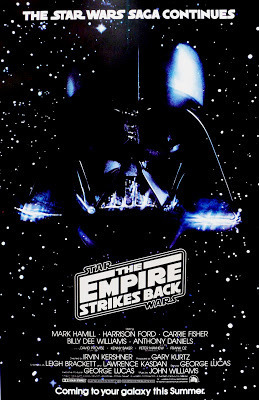
Allie's "Star Wars" kick continued with this, the best of the trilogy. From the still-thrilling battle on Hoth at the beginning to the big revelation at the end, "Empire" maintains just the right balance of spectacle, human (or alien) moments, suspense, humor and even romance. All the actors seem more comfortable in their roles this time around, and the new elements -- especially Yoda and Lando -- fit perfectly. Plus, that's one hell of a gutsy ending for a movie whose sequel wouldn't hit theaters for three years.
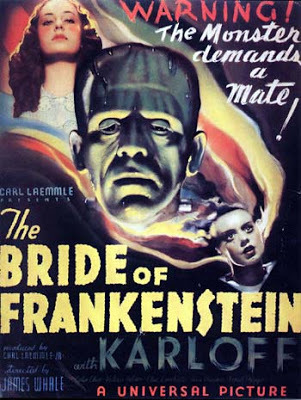
I've got the DVD, but this was starting on TCM one evening, and Allie seemed willing, so I decided to introduce her to the timeless glories of the classic Universal monster movies. It lacks the pre-Code edginess of the earlier ones, like "Frankenstein" and "The Black Cat," but it's a much more polished affair, with director James Whale knowing just what he wants to do with the continuing story of the Monster. Frankenstein's mentor, Dr. Pretorious (played with campy relish by Ernest Thesiger) was such a memorable presence that I named my line of mini-comics after him in the 1980s. And though she's only onscreen for a few minutes (and never, ever appeared in any other movie), The Bride is such a striking creation that she steals the film from everyone else. The scene at the end, where the Monster desperately strokes her hand, muttering "Friend... friend" before she rejects him is my pick for the saddest scene in classic horror cinema. I wrote a lot more about it a few years ago.
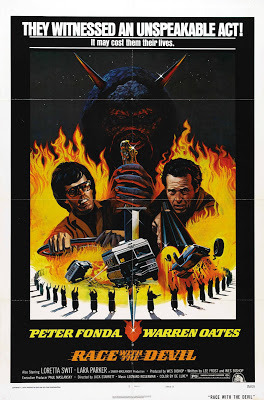
Excellent, forgotten thriller about a couple of guys (Peter Fonda and the late, great Warren Oates) who take their wives on a motor home road trip and accidentally witness a midnight sacrifice by some creepy cult. From the unnerving moment when they're spotted, "Race with the Devil" alternates between teeth-grinding tension and balls-out action sequences. Filmed, thankfully, before the days of CGI-assisted car chases, this movie is packed with the genuine article, and man, are they something to behold. Bonus points for a wonderfully downbeat '70s-style ending.
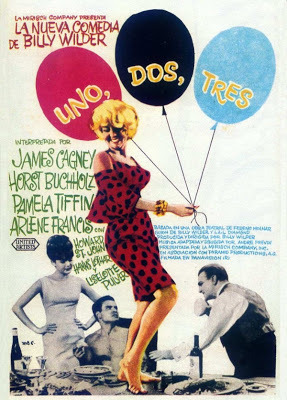
Billy Wilder's 1961 Cold War comedy is almost as exhausting to watch as it must have been to make. The great James Cagney plays C.R. MacNamara, Coca Cola's top man in West Berlin, who's trying to deal with the marriage of the boss' daughter to a slogan-spouting Communist (Horst Buchholz) at the same time he's trying to get a foothold in that oh-so-lucrative East German market. (This is just before the Berlin Wall went up, in case you were wondering.) One of the fastest comedies ever made, there's barely a moment when someone -- usually Cagney -- isn't shouting something at someone else. It's not always funny, but even when you're not laughing you're gasping in admiration at the sheer effort it took. No wonder Cagney didn't appear in another movie until 1981's "Ragtime."
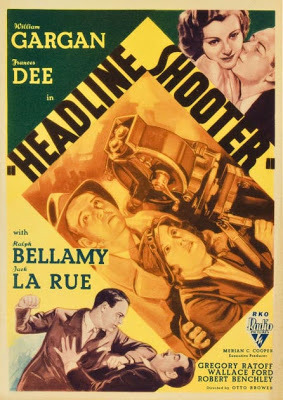
Entertaining little 1933 pre-Coder about a newsreel cameraman (William Gargan) who falls in love with a newspaper reporter (Francis Dee, a decade before "I Walked with a Zombie"). Like many movies of the era, it's not exactly a seamless narrative, with the story jumping from a beauty contest (emceed by Robert Benchley, of all people) and an earthquake before setting down into a by-the-numbers gangster tale. At times, it feels a lot like "His Girl Friday," because the plot revolves around Dee engaged to a guy who wants her to give up her fast-paced newspaper job. The oddest thing about it? In both movies, that guy is played by none other than Ralph Bellamy. Boy, he really carved out a niche for himself, didn't he?
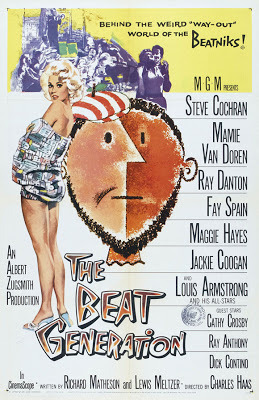
As a fan of both the actual beats and the goofball beatnik culture they inspired, I'd always wanted to see this 1959 exploitation movie from producer Albert Zugsmith. Turns out it's a surprisingly sleazy crime melodrama that could've been titled "The Beatnik Rapist." Smooth-talker Ray Danton plays Stanley Belmont aka Stan Hess aka The Guy Not to Let Into Your Apartment, Ladies. Steve Cochran, last seen by me playing a Klansman in "Storm Warning," is the cop trying to catch him -- mostly because his wife was one of the victims. Mamie Van Doren plays another victim (or would-be victim -- I honestly can't remember) and Jackie Coogan (aka Uncle Fester or The Kid in Chaplin's "The Kid") plays Cochran's partner. The rest of the cast is equally eclectic, including Vampira (with short hair), Dick Contino, Robert Mitchum's weird-looking son James and Louis Armstrong singing the least Beat-inflected jazz ever heard. Creepy plot aside, it's very entertaining in a koo-koo-kooky way, with characters named "The Singing Beatnik" (not to be confused with "The Singer"), "The Wrestling Beatnik," and "The Beat Beatnik." By the way, it was co-written by legendary author Richard Matheson, who just died last week.
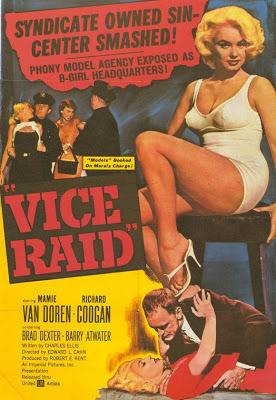
And the Mamie Van Doren festival continues, thanks to the fine folks at TCM. This one isn't nearly as much fun as "The Beat Generation." It's a stripped-down tale of police corruption and vice surrounding a gangster empire built on a rather chaste cheesecake photo/escort scheme. Mamie does strip down to that bathing suit for about five minutes, so the poster isn't technically lying.
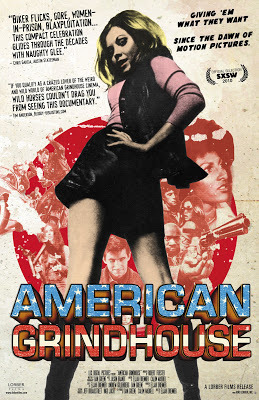
One of my favorite documentaries of the past couple of years, this is a loving, fast-paced look at exploitation cinema, dating from the silents to the modern era. Tons of clips, lots of quotes from the survivors who were involved. My only complaint is that it's not a 12-part Ken Burns-esque miniseries. Hell, I'd watch it. Repeatedly.
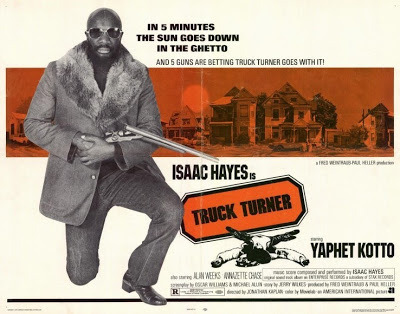
Watching this blaxploitation classic was the most movie-related fun I've had in a long time. Read all about it here.
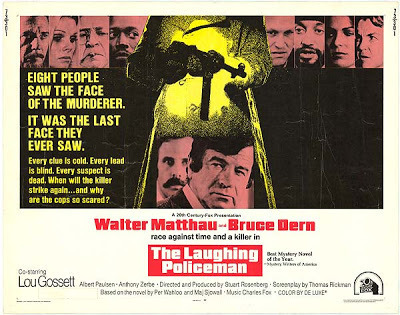
Interesting 1973 police drama that starts out so well I thought it might be a lost relation to "Zodiac." Like that movie, it begins with a shocking act of violence (an entire bus of people is machine-gunned to death) and proceeds to some deliberately low-key, realistic police investigation. Unfortunately, it can't quite maintain that tone and gets a little too quirky and rambling for its own good. Matthau, of course, is excellent, and Bruce Dern lightens things up nicely as his partner. The best thing about it, beside those two performances, is all the authentic 1970s San Francisco period detail. There are some low-rent go-go clubs where Matthau searches for clues, and Dern has a memorable scene trailing a suspect into a vintage leather bar. Bruce doesn't have the costume, but look at that poster -- he definitely has the right mustache.
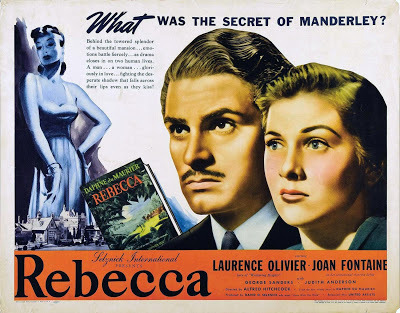
And, to round out the month, something from the "classics/classy" file." Amy and I actually started watching this sometime last month, but our DVR screwed up the recording so I had to wait for TCM to air it again. I'd never seen it before, and maybe it was the month-long gap between viewings, but I wasn't blown away. I mean, it's definitely a good movie, with strong performances, a compelling story and beautiful misty cinematography, but as Hitchcock's only Oscar-winning film (though David O.Selznick, as the producer, claimed that Best Picture trophy), I didn't think it measured up to his other classics, like "Shadow of a Doubt," "Strangers on a Train" or even something earlier, like "Sabotage." Still, I like any movie that (a) never shows the title character (don't let that image on the poster fool you) and (b) never names the main character (Joan Fontaine is merely known as "Mrs. de Winter" -- gets bonus points for the effort.
Published on June 29, 2013 18:49
June 23, 2013
You need to watch ' Truck Turner'
This week, I watched the 1975 blaxploitation classic "Truck Turner," starring Isaac Hayes as former football player and current "skip tracer" (aka bounty hunter) Mack "Truck" Turner. I expected a few cheap chuckles, but I wound up enjoying it quite a bit. I'm haven't seen every blaxploitation movie by a long shot, but I'd rank "Truck Turner" near the very top of the list. It's fun, it's exciting, it's crazy violent and it packs plenty of surprises and memorable moments.
For example...
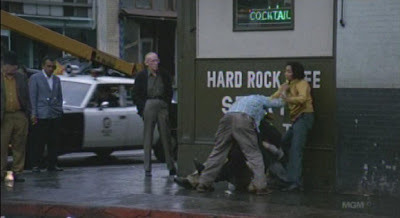
The opening credits feature what looks like genuine footage of Los Angeles derelicts slugging it out in front of a bar called ... the Hard Rock Cafe.
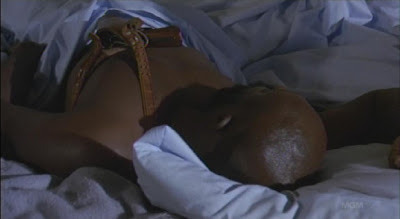
Truck lives in a filthy, tiny apartment and sleeps in a pile of fast food wrappers and empty beer cans. But he does wear his shoulder holster and pistol to bed.
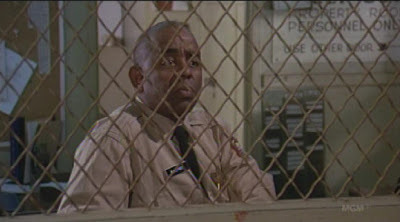
Playing the clerk at the jail? Why, it's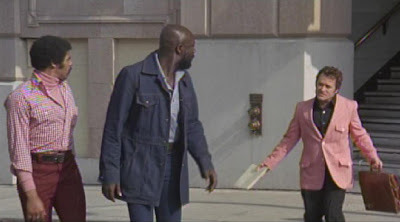
And here's B-movie stalwart Dick Miller, wearing a pink sport coat.
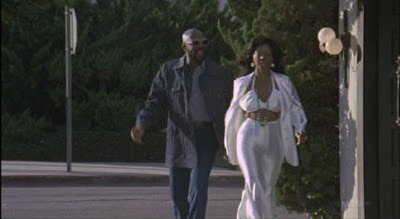
Nichelle Nichols, aka Uhuru from "Star Trek," has a major role as Dorinda, a mean, incredibly foul-mouthed madame. And, in her opening scene, she wears this amazing outfit.
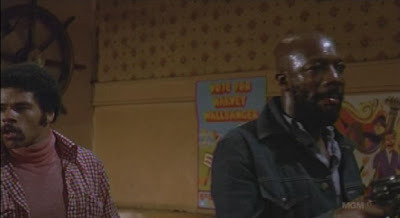
During a fight in a bar, Truck and his buddy Jerry (Alan Weeks) stand in front of a poster that says "Vote for Harvey Wallbanger."
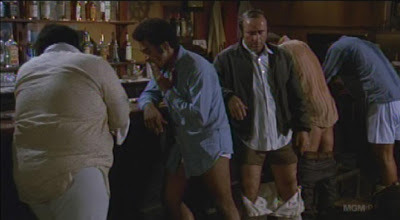
Later in that same scene, after Truck wins the fight, he orders the other guys in the bar to drop their pants and leave them down ... and they DO.
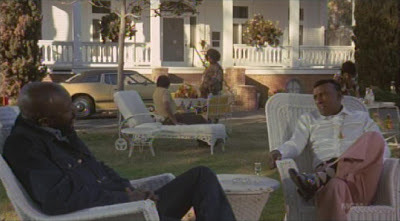
Not to be outdone by Dick Miller or Nichelle Nichols, Scatman Crothers shows up as an ex-pimp and wears argyle socks, pink pants, a satin shirt, a gold chain and the worst toupee in movie history.
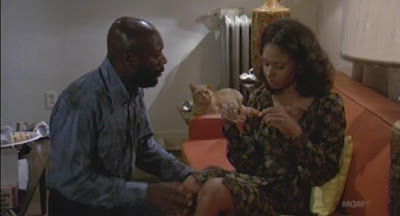
After getting his shoplifting girlfriend (Annazette Chase) out of jail, Truck buys her an order of Kentucky Fried Chicken and takes her back to his awful apartment before romancing her. During this scene, Truck's cat never takes his eyes off that chicken leg.
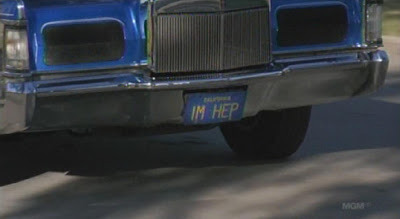
During a funeral procession for Gator, a pimp killed (of course) by Truck, this license plate makes an appearance.
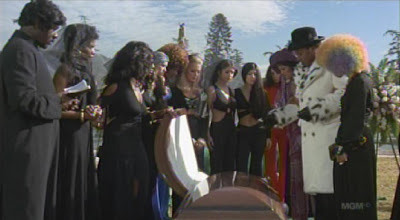
A few minutes later, this rainbow wig makes an appearance at the graveside service.

And we're treated to some POV shots from the coffin, including this snazzily dressed fellow with a glittery eye patch and bedazzled suit.
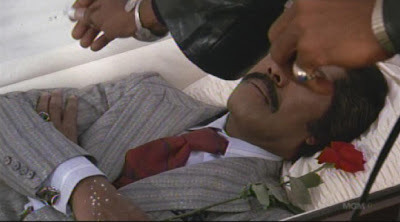
We also get a few shots of the pimps paying tribute to their fallen comrade by sprinkling cocaine on Gator's dead body.
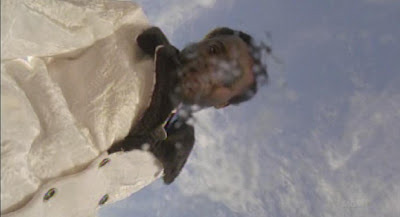
One fellow not paying tribute is rival pimp and top gangster Harvard Blue (Yaphet Kotto), who spits on the body in another great POV shot.
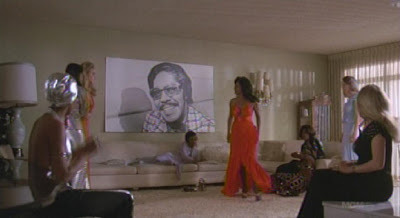
After the funeral, Dorinda is furious about Truck killing Gator. Her devotion to the late gentleman of leisure is apparent, given the giant poster of him she still has hanging in her living room. She gathers the other pimps and offers a financial cut of her stable to the one who kills Truck -- which leads to some great action scenes of various colorfully dressed characters targeting our hero.
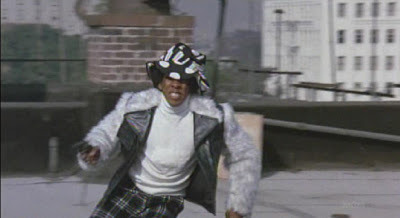
This, for example, is how one of the would-be assassins dresses for his ill-fated meeting with Truck Turner...
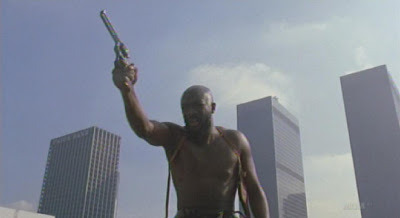
... and this is how Truck, interrupted in the middle of feeding his cat, dresses to take the assassin down.
I've joked a lot about the over-the-top look of "Truck Turner," but the truth is this movie knows exactly what it's doing, and the comedic and outrageous moments are completely deliberate. It's not so bad it's good, it's genuinely good, delivering a fast-paced, action-packed story with colorful characters and some fun plot twists. And just look at that shot of Hayes with the buildings of Los Angeles behind him. Director Jonathan Kaplan knows how to make a visually interesting movie, and he really knows how take advantage his Los Angeles locations. The chase scenes alone make the movie worth watching as a sort of mid-70s L.A. travelogue.
For example...

The opening credits feature what looks like genuine footage of Los Angeles derelicts slugging it out in front of a bar called ... the Hard Rock Cafe.

Truck lives in a filthy, tiny apartment and sleeps in a pile of fast food wrappers and empty beer cans. But he does wear his shoulder holster and pistol to bed.

Playing the clerk at the jail? Why, it's

And here's B-movie stalwart Dick Miller, wearing a pink sport coat.

Nichelle Nichols, aka Uhuru from "Star Trek," has a major role as Dorinda, a mean, incredibly foul-mouthed madame. And, in her opening scene, she wears this amazing outfit.

During a fight in a bar, Truck and his buddy Jerry (Alan Weeks) stand in front of a poster that says "Vote for Harvey Wallbanger."

Later in that same scene, after Truck wins the fight, he orders the other guys in the bar to drop their pants and leave them down ... and they DO.

Not to be outdone by Dick Miller or Nichelle Nichols, Scatman Crothers shows up as an ex-pimp and wears argyle socks, pink pants, a satin shirt, a gold chain and the worst toupee in movie history.

After getting his shoplifting girlfriend (Annazette Chase) out of jail, Truck buys her an order of Kentucky Fried Chicken and takes her back to his awful apartment before romancing her. During this scene, Truck's cat never takes his eyes off that chicken leg.

During a funeral procession for Gator, a pimp killed (of course) by Truck, this license plate makes an appearance.

A few minutes later, this rainbow wig makes an appearance at the graveside service.

And we're treated to some POV shots from the coffin, including this snazzily dressed fellow with a glittery eye patch and bedazzled suit.

We also get a few shots of the pimps paying tribute to their fallen comrade by sprinkling cocaine on Gator's dead body.

One fellow not paying tribute is rival pimp and top gangster Harvard Blue (Yaphet Kotto), who spits on the body in another great POV shot.

After the funeral, Dorinda is furious about Truck killing Gator. Her devotion to the late gentleman of leisure is apparent, given the giant poster of him she still has hanging in her living room. She gathers the other pimps and offers a financial cut of her stable to the one who kills Truck -- which leads to some great action scenes of various colorfully dressed characters targeting our hero.

This, for example, is how one of the would-be assassins dresses for his ill-fated meeting with Truck Turner...

... and this is how Truck, interrupted in the middle of feeding his cat, dresses to take the assassin down.
I've joked a lot about the over-the-top look of "Truck Turner," but the truth is this movie knows exactly what it's doing, and the comedic and outrageous moments are completely deliberate. It's not so bad it's good, it's genuinely good, delivering a fast-paced, action-packed story with colorful characters and some fun plot twists. And just look at that shot of Hayes with the buildings of Los Angeles behind him. Director Jonathan Kaplan knows how to make a visually interesting movie, and he really knows how take advantage his Los Angeles locations. The chase scenes alone make the movie worth watching as a sort of mid-70s L.A. travelogue.
Published on June 23, 2013 21:16
June 20, 2013
Great Moments in Comics History, Part 25
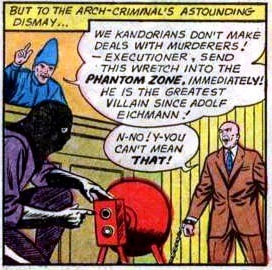
The citizens of Kandor prove they keep up on Earth's current events.
"The Death of Superman!," Superman #149 (Nov. 1961), script by Jerry Siegel, pencils by Curt Swan, inks by Sheldon Moldoff
Published on June 20, 2013 04:45
June 13, 2013
Great Moments in Comics History, Part 24

Luthor sees the big picture.
All-Star Superman #12, script by Grant Morrison, pencils by Frank Quitely, inks and colors by Jamie Grant, letters by Travis Lanham.
Published on June 13, 2013 20:13
June 7, 2013
Movies I watched in May, Part 2
Continuing the roundup of last month's movies...
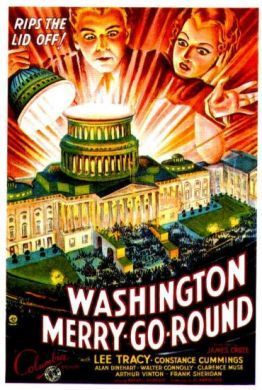
The great Lee Tracy (one of my favorite Pre-Code actors) stars in this comedy/drama about a fresh-faced young fast-talker (Tracy, natch) who storms into Washington figuring he can straighten things out and makes a lot of powerful enemies when he tries to do something about all that awful corruption. Originally released in 1932, it's like a less wide-eyed version of "Mr. Smith Goes to Washington," with Tracy (much) more savvy than Jimmy Stewart's character and the ending (much, much) darker. In the Capra film, corrupt politician Claude Rains makes a half-hearted suicide attempt but is stopped by his colleagues. In this movie, Tracy leaves the villain alone with a gun with no one doubting what he's supposed to do next. And sure enough, the movie ends with a gunshot. Grim year, 1932. Grim year.
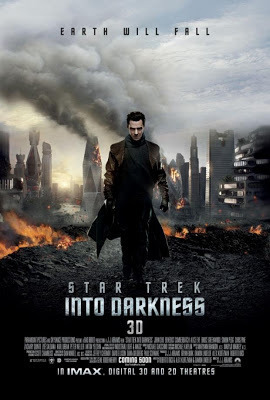
A lot of fun, and there's no doubt Benedict Cumberbatch makes a truly great villain. I like these J.J. Abrams versions of old "Star Trek" stories, but without spoiling anything, let me say this: I could've done without the specific lines (assigned to different) characters aimed at playing off the other time this story was told. If you saw the movie, I think you'll know what I mean. Also, even though the bad guy was beaten, it seems like he accomplished what he set out to do: the death toll in downtown San Francisco must've been somewhere in the low millions, right?
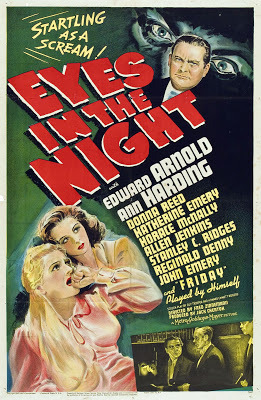
More of the great Edward Arnold, this time playing a blind detective investigating a secret Nazi spy ring that's using a regional theater as its base of operations. (It was 1942, after all.) The plot is beyond ridiculous, with a dedicated scientist working on some MacGuffin aimed at winning the war, his wife an old friend of Arnold's, and his daughter (Donna Reed, a mere 21-years-old) in love with one of the Nazis. None of that matters, however, because the fun comes from watching Arnold outfox, outfight and generally outperform everyone else in this movie blessed with a pair of working peepers. He's pretty convincing as the sightless hero, and he seems to be having a blast playing the part. His dog Friday (playing, apparently, himself) is no slouch either.
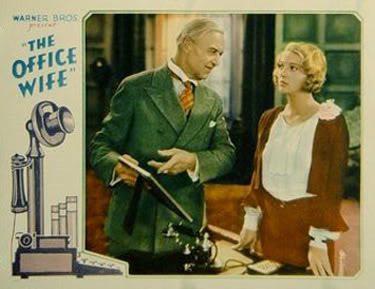
About eight years before he started playing a paragon of virtue in MGM's "Andy Hardy" movies, Lewis Stone co-starred with Dorothy Mackaill in this would-be scandalous shocker about the women who fall in love with rich executives and the rich executives who fall in love with them. As pre-Coders go, this one is tame, with the central romance fairly chaste and Stone's wife sliding effortlessly out of the marriage with a lover of her own. However, it is worth watching for two reasons: One: Joan Blondell, in only her second full-length film (she's still partly brunette, in fact), plays Mackaill's roommate and shows up every so often to strip down and give the movie a little zip and zing. And two: Blanche Friderici plays an author named Kate Halsey, who happens to be working on a book exposing the scandal of (what else?) "office wives." What makes ol' Kate so memorable is that, without any actual mention of her sexual leanings, she's the most blatant screen lesbian I've ever seen -- man-style suits, cigars, and a more masculine bearing than wishy-washy Lewis Stone, that's for sure. It's always amazing what they managed to sneak into those old movies.
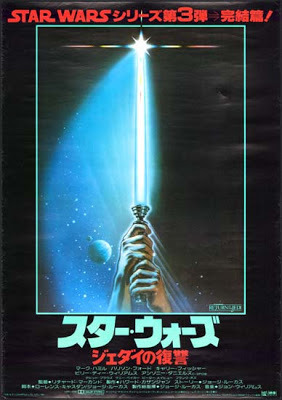
Still on her "Star Wars" kick, Allie wanted to watch "the one where Darth Vader throws the Emperor," so I popped "Return of the Jedi" into the player. It's definitely the weakest of the original three, but it still has its moments, including the speeder bike chases and just about everything involving Luke. This, like my other DVDs, has the "special edition" additions, and the musical number added to Jabba's palace might be the greatest crime on Lucas' resume ... until, of course, the prequels. By the way, as long as we're talking about "Jedi," can someone explain why Boba Fett is so beloved? He does absolutely nothing in any of these movies aside from following the Millennium Falcon to Bespin in "Empire," then he idiotically trips and falls into that monster in the Tatooine desert. What a loser.
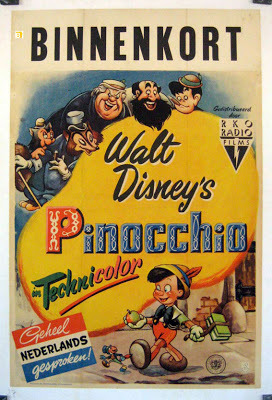
Beautifully animated, sure, but one very grim movie. Have you seen it lately? When Pinocchio is taken to Pleasure Island (as Admiral Akbar from one movie up would warn, "It's a trap."), he's partly turned into a donkey but escapes with the help of Jiminy Cricket. Trouble is, all those other boys (hundred? thousands?) do not escape and are, in fact, completely turned into donkeys and shipped of to serve as slave labor all over the globe. At the end of the movie, when Geppetto is celebrating the fact that his little puppet has become a real live boy, plenty of former real,live boys are working themselves to a slow death just because they once misbehaved a bit, too. Where's the justice in that? (I have to say, though, that the idea of a beautiful house that exists only to be wrecked is a pretty appealing idea, and I was never even that bad a boy. I would've been doomed to donkey-hood for sure.)
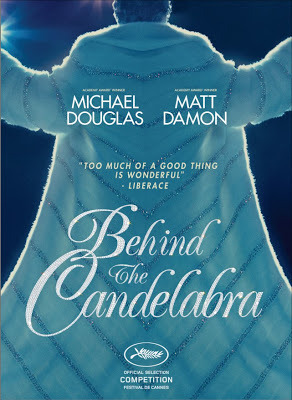
Beautifully done biopic that's supposedly the last film from director Steven Soderbergh, and if so, that's a damned shame. (Why can't someone like Tyler Perry or Michael Bay call it quits instead?) Michael Douglas plays a perfect Liberace, giving the role the necessary flamboyance (how could he not?) while still reminding us that there was an actual human being under all those rhinestones (and, it turns out, those toupees). Matt Damn is just as good as Scott Thorsen, creating a character who gets caught up in a crazy -- but intoxicating -- world he can barely understand. What's really surprising about "Behind the Candelabra" is that it makes that crazy world believable and makes the love story at the center of it genuine and powerful. It would've been so easy for all involved -- especially Douglas -- to deliver one big gay joke, but this is a much richer viewing experience than that. If you're a fan of Liberace, showbiz, Vegas or all-American kitsch, I highly recommend you tune in.
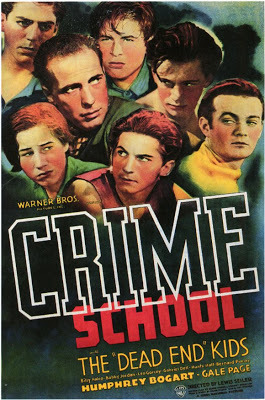
About three years before he became a major star in "The Maltese Falcon," Humphrey Bogart was second-billed to the Dead End Kids in this 1938 movie about a bunch of good-hearted bad boys (guess who?) tossed behind bars because they wouldn't squeal on each other. There's not a whole lot that's interesting about this movie, I'll admit, so instead of rambling on here, I'll share the comments I Tweeted while watching it. (Follow me on Twitter at @willpfeifer if this is the sort of old movie nonsense you crave)
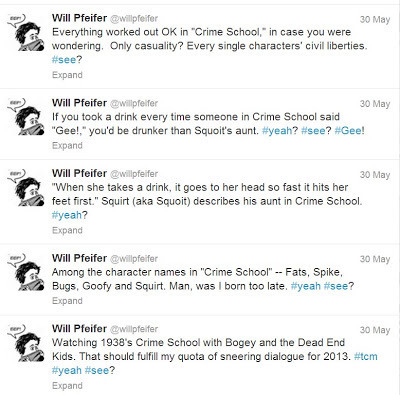

The great Lee Tracy (one of my favorite Pre-Code actors) stars in this comedy/drama about a fresh-faced young fast-talker (Tracy, natch) who storms into Washington figuring he can straighten things out and makes a lot of powerful enemies when he tries to do something about all that awful corruption. Originally released in 1932, it's like a less wide-eyed version of "Mr. Smith Goes to Washington," with Tracy (much) more savvy than Jimmy Stewart's character and the ending (much, much) darker. In the Capra film, corrupt politician Claude Rains makes a half-hearted suicide attempt but is stopped by his colleagues. In this movie, Tracy leaves the villain alone with a gun with no one doubting what he's supposed to do next. And sure enough, the movie ends with a gunshot. Grim year, 1932. Grim year.

A lot of fun, and there's no doubt Benedict Cumberbatch makes a truly great villain. I like these J.J. Abrams versions of old "Star Trek" stories, but without spoiling anything, let me say this: I could've done without the specific lines (assigned to different) characters aimed at playing off the other time this story was told. If you saw the movie, I think you'll know what I mean. Also, even though the bad guy was beaten, it seems like he accomplished what he set out to do: the death toll in downtown San Francisco must've been somewhere in the low millions, right?

More of the great Edward Arnold, this time playing a blind detective investigating a secret Nazi spy ring that's using a regional theater as its base of operations. (It was 1942, after all.) The plot is beyond ridiculous, with a dedicated scientist working on some MacGuffin aimed at winning the war, his wife an old friend of Arnold's, and his daughter (Donna Reed, a mere 21-years-old) in love with one of the Nazis. None of that matters, however, because the fun comes from watching Arnold outfox, outfight and generally outperform everyone else in this movie blessed with a pair of working peepers. He's pretty convincing as the sightless hero, and he seems to be having a blast playing the part. His dog Friday (playing, apparently, himself) is no slouch either.

About eight years before he started playing a paragon of virtue in MGM's "Andy Hardy" movies, Lewis Stone co-starred with Dorothy Mackaill in this would-be scandalous shocker about the women who fall in love with rich executives and the rich executives who fall in love with them. As pre-Coders go, this one is tame, with the central romance fairly chaste and Stone's wife sliding effortlessly out of the marriage with a lover of her own. However, it is worth watching for two reasons: One: Joan Blondell, in only her second full-length film (she's still partly brunette, in fact), plays Mackaill's roommate and shows up every so often to strip down and give the movie a little zip and zing. And two: Blanche Friderici plays an author named Kate Halsey, who happens to be working on a book exposing the scandal of (what else?) "office wives." What makes ol' Kate so memorable is that, without any actual mention of her sexual leanings, she's the most blatant screen lesbian I've ever seen -- man-style suits, cigars, and a more masculine bearing than wishy-washy Lewis Stone, that's for sure. It's always amazing what they managed to sneak into those old movies.

Still on her "Star Wars" kick, Allie wanted to watch "the one where Darth Vader throws the Emperor," so I popped "Return of the Jedi" into the player. It's definitely the weakest of the original three, but it still has its moments, including the speeder bike chases and just about everything involving Luke. This, like my other DVDs, has the "special edition" additions, and the musical number added to Jabba's palace might be the greatest crime on Lucas' resume ... until, of course, the prequels. By the way, as long as we're talking about "Jedi," can someone explain why Boba Fett is so beloved? He does absolutely nothing in any of these movies aside from following the Millennium Falcon to Bespin in "Empire," then he idiotically trips and falls into that monster in the Tatooine desert. What a loser.

Beautifully animated, sure, but one very grim movie. Have you seen it lately? When Pinocchio is taken to Pleasure Island (as Admiral Akbar from one movie up would warn, "It's a trap."), he's partly turned into a donkey but escapes with the help of Jiminy Cricket. Trouble is, all those other boys (hundred? thousands?) do not escape and are, in fact, completely turned into donkeys and shipped of to serve as slave labor all over the globe. At the end of the movie, when Geppetto is celebrating the fact that his little puppet has become a real live boy, plenty of former real,live boys are working themselves to a slow death just because they once misbehaved a bit, too. Where's the justice in that? (I have to say, though, that the idea of a beautiful house that exists only to be wrecked is a pretty appealing idea, and I was never even that bad a boy. I would've been doomed to donkey-hood for sure.)

Beautifully done biopic that's supposedly the last film from director Steven Soderbergh, and if so, that's a damned shame. (Why can't someone like Tyler Perry or Michael Bay call it quits instead?) Michael Douglas plays a perfect Liberace, giving the role the necessary flamboyance (how could he not?) while still reminding us that there was an actual human being under all those rhinestones (and, it turns out, those toupees). Matt Damn is just as good as Scott Thorsen, creating a character who gets caught up in a crazy -- but intoxicating -- world he can barely understand. What's really surprising about "Behind the Candelabra" is that it makes that crazy world believable and makes the love story at the center of it genuine and powerful. It would've been so easy for all involved -- especially Douglas -- to deliver one big gay joke, but this is a much richer viewing experience than that. If you're a fan of Liberace, showbiz, Vegas or all-American kitsch, I highly recommend you tune in.

About three years before he became a major star in "The Maltese Falcon," Humphrey Bogart was second-billed to the Dead End Kids in this 1938 movie about a bunch of good-hearted bad boys (guess who?) tossed behind bars because they wouldn't squeal on each other. There's not a whole lot that's interesting about this movie, I'll admit, so instead of rambling on here, I'll share the comments I Tweeted while watching it. (Follow me on Twitter at @willpfeifer if this is the sort of old movie nonsense you crave)

Published on June 07, 2013 21:55
June 1, 2013
Movies I watched in May, Part 1
Unlike last month, where real life (and, admittedly, new TV shows) resulted in a lackluster total of movies watched, this month was packed with films. So many, in fact, that I'm splitting the May roundup into a double feature. Here's the first half...
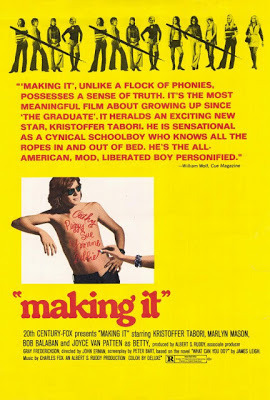
Not the disco-themed, short-lived TV series starring David Naughton aimed at cashing in on the "Saturday Night Fever" craze. That came later. This is a mostly forgotten teen comedy from 1971, focusing on Phil Fuller, a laid-back high school student coasting through life with zen aplomb. He's played by
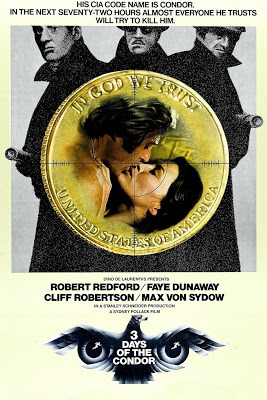
I love 1970s conspiracy movies, but I'd put this one a notch below "The Parallax View" and "All the President's Men," if only because I can never buy Faye Dunaway falling head over heels for Robert Redford after he abducts her and holds her hostage in her own apartment. I mean sure, he's a young Robert Redford, but c'mon. Having said that, the rest of the movie is very good, with some nicely ironic Christmas decorations and a great performance by Max Von Sydow as the most practical assassin in movie history.
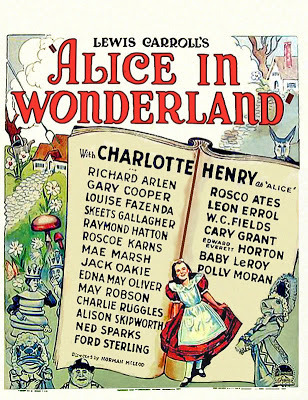
Now here's a real oddity: a star-studded, consistently surreal version of "Alice in Wonderland" where most of the biggest names -- including Cary Grant, W.C. Fields and Gary Cooper -- are virtually unrecognizable (you never even glimpse Grant's face except for his card in the opening credits). Visually, it's pretty amazing, with nightmare-inducing costumes (I mean that in the best possible way) and strangely evocative sets. Weirdest moment? The croquet game is, just like in the story, played with flamingos as mallets. Real, live flamingos. Well, at least they were live when the cameras started to roll...
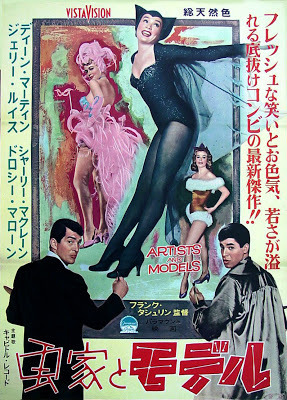
Being a big Frank Tashlin fan, a huge Martin and Lewis fan, and an even bigger comic book fan, it's odd I'd never seen "Artists and Models," the 1955 live-action cartoon that combines all three elements. Things start off a little slow, with Dean a struggling artist and Jerry, well, Jerry, but once the subplot of The Bat Lady comic book gets going, it's a lot of fun, filmed in Tashlin's distinctly colorful style. And boy oh boy, is Shirley MacLaine a cutie in that Bat Lady costume. No wonder Jerry was so smitten.
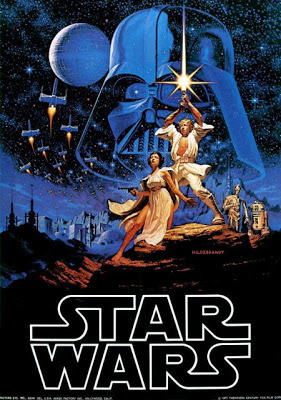
Well, Allie wanted to watch it, and who was I to say no? I chose the above image because that's the poster that hung over my bed in the summer of 1977. Not exactly Carrie Fisher and Mark Hamill, but who cares? Unfortunately, the version Allie and I watched last month was not the version I saw back in '77, and I had to endure all that annoying CGI bric-a-brac that Lucas insisted on adding to make the movie "special." (If you want to see something truly awful, watch the much-hyped scene with Han and Jabba.) Still, any version of "Star Wars" has its moments, namely that first shot of the Star Destroyer flying overhead. (Sad but true fact: I divide my life between the moment before I saw that shot and after.) And the ending, with Luke making the Death Star run, as I've said before, always gets me on the edge of my seat. It's a master class in suspenseful editing, with Luke still flying toward the target after the Death Star has, technically speaking, already pulled the trigger.
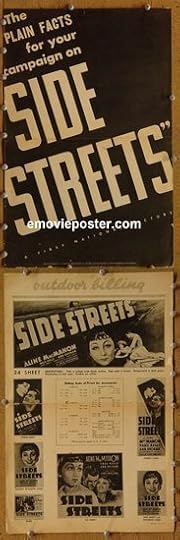
Offbeat Pre-Code drama starring two of my favorite actresses of the era, Ann Dvorak and Aline MacMahon. MacMahon owns a fur shop in Depression-era San Francisco, and she falls in love with Tim, a ne'er-do-well who claims to be a sailor (Paul Kelly). Tim's a nice enough guy, but he starts an affair with Dvorak, though he's decent enough to break it off when MacMahon becomes pregnant. There are a few big plot twists both tragic and preposterous, but what makes the movie special is the low-key portrait of a sensible businesswoman trying to earn a living in a tough world. Dvorak is great, bringing a world-weary sense to her performance, but this is MacMahon's show all the way.
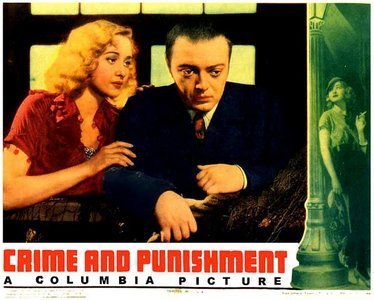
I recorded this 1935 version of "Crime and Punishment" off TCM because the onscreen listing mentioned that it starred two of my favorite actors, Peter Lorre (as Raskolnikov) and Edward Arnold (as Inspector Porfiry, who pursues him). What I didn't realize until I actually sat down and watched the movie that it also stars yet another of my favorite pre-Code actresses, Marian Marsh, and was directed by none other than the great Josef Von Sternberg. Admittedly, this is post-peak Josef, after he helmed such classics as "The Blue Angel," "The Scarlett Empress" and the three movies contained on this impressive Criterion set. But even so, I thought this was a hell of a movie, compacting Dostoevsky's long novel into a compact -- but not simplistic -- 88 minutes. Lorre is perfect as the twitchy murderer, of course, but so is Arnold, bringing a sense of arrogant joie de vivre to his cop role. (Look for more Edward Arnold in part two of this recap.)
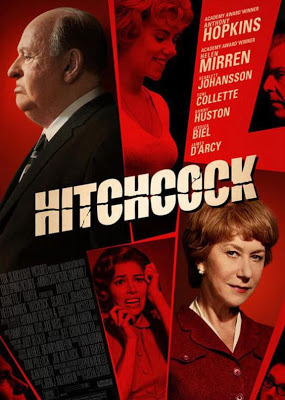
If you don't care one bit about how "Psycho" was really made and just want to see a talented cast re-enact scenes that probably never too place, have I got the movie for you. Old-time Hollywood bios and "true stories" never worried about bringing the audience historical facts, and neither does "Hitchcock." It's fun, though with Scar Jo doing a surprisingly good Janet Leigh impersonation and Helen Mirren unsurprisingly sharp as Alma Hitchcock. (Best of all, though, is James D'Arcy, channeling Anthony Perkins.) As for the title role, Anthony Hopkins isn't bad, but you never forget that you're not watching Hitch himself. Maybe it's because -- thanks to his TV show -- we've all seen so much footage of Hitchcock that the genuine article remains stuck in our mind. Or maybe it's because Hopkins -- whose hammy tendencies are perfect for this slightly silly story -- is just as familiar to us, minus the fake chin and fat suit.
Up next: More"Star Wars," a little Liberace and, believe it or not, an actual trip to a theater.

Not the disco-themed, short-lived TV series starring David Naughton aimed at cashing in on the "Saturday Night Fever" craze. That came later. This is a mostly forgotten teen comedy from 1971, focusing on Phil Fuller, a laid-back high school student coasting through life with zen aplomb. He's played by

I love 1970s conspiracy movies, but I'd put this one a notch below "The Parallax View" and "All the President's Men," if only because I can never buy Faye Dunaway falling head over heels for Robert Redford after he abducts her and holds her hostage in her own apartment. I mean sure, he's a young Robert Redford, but c'mon. Having said that, the rest of the movie is very good, with some nicely ironic Christmas decorations and a great performance by Max Von Sydow as the most practical assassin in movie history.

Now here's a real oddity: a star-studded, consistently surreal version of "Alice in Wonderland" where most of the biggest names -- including Cary Grant, W.C. Fields and Gary Cooper -- are virtually unrecognizable (you never even glimpse Grant's face except for his card in the opening credits). Visually, it's pretty amazing, with nightmare-inducing costumes (I mean that in the best possible way) and strangely evocative sets. Weirdest moment? The croquet game is, just like in the story, played with flamingos as mallets. Real, live flamingos. Well, at least they were live when the cameras started to roll...

Being a big Frank Tashlin fan, a huge Martin and Lewis fan, and an even bigger comic book fan, it's odd I'd never seen "Artists and Models," the 1955 live-action cartoon that combines all three elements. Things start off a little slow, with Dean a struggling artist and Jerry, well, Jerry, but once the subplot of The Bat Lady comic book gets going, it's a lot of fun, filmed in Tashlin's distinctly colorful style. And boy oh boy, is Shirley MacLaine a cutie in that Bat Lady costume. No wonder Jerry was so smitten.

Well, Allie wanted to watch it, and who was I to say no? I chose the above image because that's the poster that hung over my bed in the summer of 1977. Not exactly Carrie Fisher and Mark Hamill, but who cares? Unfortunately, the version Allie and I watched last month was not the version I saw back in '77, and I had to endure all that annoying CGI bric-a-brac that Lucas insisted on adding to make the movie "special." (If you want to see something truly awful, watch the much-hyped scene with Han and Jabba.) Still, any version of "Star Wars" has its moments, namely that first shot of the Star Destroyer flying overhead. (Sad but true fact: I divide my life between the moment before I saw that shot and after.) And the ending, with Luke making the Death Star run, as I've said before, always gets me on the edge of my seat. It's a master class in suspenseful editing, with Luke still flying toward the target after the Death Star has, technically speaking, already pulled the trigger.

Offbeat Pre-Code drama starring two of my favorite actresses of the era, Ann Dvorak and Aline MacMahon. MacMahon owns a fur shop in Depression-era San Francisco, and she falls in love with Tim, a ne'er-do-well who claims to be a sailor (Paul Kelly). Tim's a nice enough guy, but he starts an affair with Dvorak, though he's decent enough to break it off when MacMahon becomes pregnant. There are a few big plot twists both tragic and preposterous, but what makes the movie special is the low-key portrait of a sensible businesswoman trying to earn a living in a tough world. Dvorak is great, bringing a world-weary sense to her performance, but this is MacMahon's show all the way.

I recorded this 1935 version of "Crime and Punishment" off TCM because the onscreen listing mentioned that it starred two of my favorite actors, Peter Lorre (as Raskolnikov) and Edward Arnold (as Inspector Porfiry, who pursues him). What I didn't realize until I actually sat down and watched the movie that it also stars yet another of my favorite pre-Code actresses, Marian Marsh, and was directed by none other than the great Josef Von Sternberg. Admittedly, this is post-peak Josef, after he helmed such classics as "The Blue Angel," "The Scarlett Empress" and the three movies contained on this impressive Criterion set. But even so, I thought this was a hell of a movie, compacting Dostoevsky's long novel into a compact -- but not simplistic -- 88 minutes. Lorre is perfect as the twitchy murderer, of course, but so is Arnold, bringing a sense of arrogant joie de vivre to his cop role. (Look for more Edward Arnold in part two of this recap.)

If you don't care one bit about how "Psycho" was really made and just want to see a talented cast re-enact scenes that probably never too place, have I got the movie for you. Old-time Hollywood bios and "true stories" never worried about bringing the audience historical facts, and neither does "Hitchcock." It's fun, though with Scar Jo doing a surprisingly good Janet Leigh impersonation and Helen Mirren unsurprisingly sharp as Alma Hitchcock. (Best of all, though, is James D'Arcy, channeling Anthony Perkins.) As for the title role, Anthony Hopkins isn't bad, but you never forget that you're not watching Hitch himself. Maybe it's because -- thanks to his TV show -- we've all seen so much footage of Hitchcock that the genuine article remains stuck in our mind. Or maybe it's because Hopkins -- whose hammy tendencies are perfect for this slightly silly story -- is just as familiar to us, minus the fake chin and fat suit.
Up next: More"Star Wars," a little Liberace and, believe it or not, an actual trip to a theater.
Published on June 01, 2013 21:24
May 28, 2013
Great Moments in Comics History, Part 23
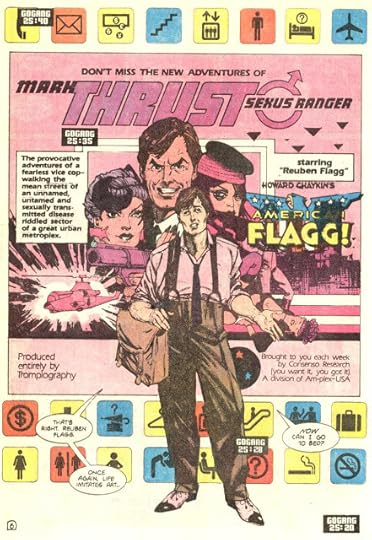
Wearing a pair of pink wingtips, Reuben Flagg, former star of "Mark Thrust, Sexus Ranger," arrives in Chicago.
American Flagg #1, script and art by Howard Chaykin, letters by Ken Bruzenak, colors by Lynn Varley
Published on May 28, 2013 18:24
May 21, 2013
Great Moments in Comics History, Part 22
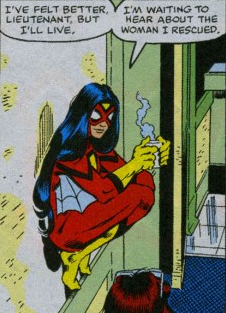
Spider-Woman sits on a wall and drinks a cup of coffee.
Avengers Annual #10, 1982, script by Chris Claremont, pencils and colors by Michael Golden, inks by Armando Gil, letters by Joe Rosen
You know, I usually don't offer any comments on these panels and let them speak for themselves, but is it possible that this single shot of a super-hero having a casual conversation (periods only -- no exclamation points) while enjoying a beverage single-handedly sparked the whole let's-sit-around-a-table-instead-of-fighting-crime deconstruction movement that overtook comics about two decades later?
Published on May 21, 2013 18:31
May 17, 2013
Pre-Code Favorites, Part 2: The Ladies
The last entry focused on the guys who gave
Pre-Code cinema
its zing, this time around the spotlight shines on the dames what gave it its sass. Some folks prefer actresses like Kay Francis and Norma Shearer, who starred in serious Pre-Coders focusing on high-toned marital problems, but I've always gravitated toward the rough-and-tumble pictures from studios like Warner Bros. that focused on fast-talking dames trying to scratch out a decent living in this crazy world. Hence, the following selections...
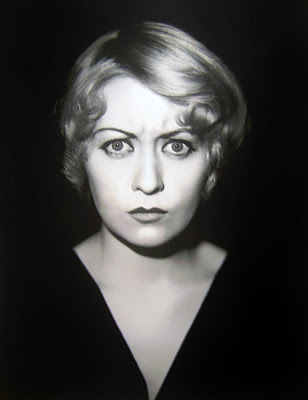
Joan Blondell: "The Public Enemy," "Night Nurse," "Gold Diggers of 1933," "Footlight Parade," "Blondie Johnson," "Havana Widows," "Three on a Match," "The Crowd Roars," "Other Men's Women," "Lawyer Man," "Blonde Crazy." (Queen of the Pre-Codes, as far as I'm concerned -- and a pretty impressive career after the Code, too.)
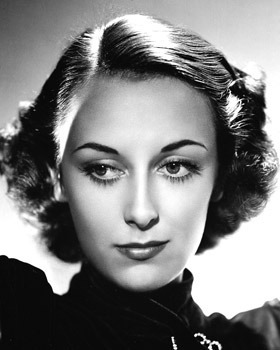
Ann Dvorak: "Scarface," "Three on a Match," "The Strange Love of Molly Louvain," Side Streets," "Massacre," "The Crowd Roars"
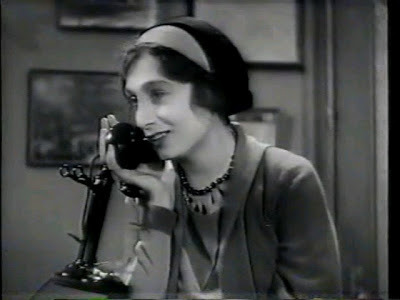
Aline MacMahon: "Five Star Final," "Side Streets," "Gold Diggers of 1933," "The Mouthpiece," "Heroes for Sale"
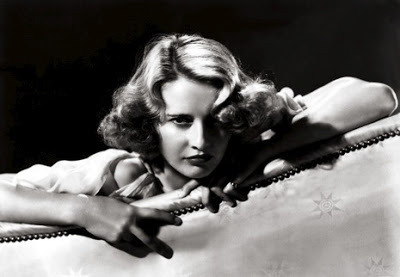
Barbara Stanwyck: "Night Nurse," "Ladies They Talk About," "Baby Face," "Ten Cents a Dance"
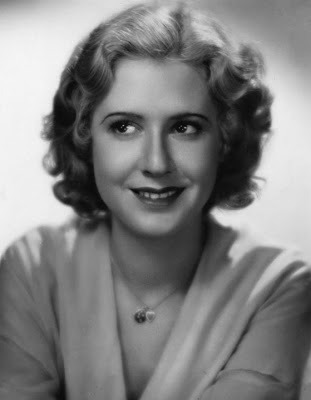
Mae Clarke: "Night World," "The Public Enemy," "Frankenstein," "Waterloo Bridge," "Fast Workers," "The Man With Two Faces," "Turn Back the Clock"
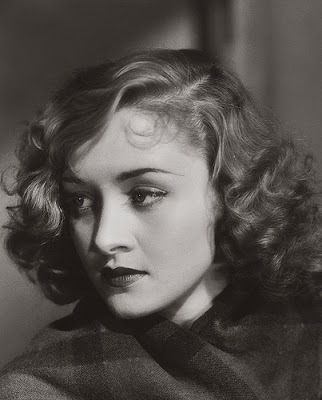
Marion Marsh: "Five Star Final," "Under 18," "Beauty and the Boss" (She's also in a great Josef Von Sternberg version of "Crime and Punishment" that, being released in 1935, just misses the Pre-Code era. Look for a review sometime around June 1, in this blog's monthly movie recap.)
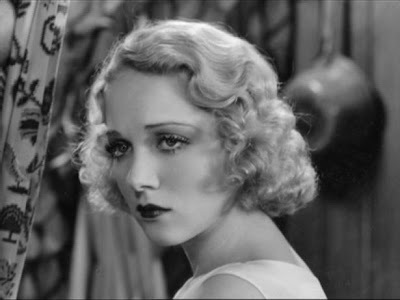
Leila Hyams: "Freaks," "Isle of Lost Souls" (I've only seen her in those two movies, but c'mon -- as taboo-breaking horror movies go, that's a hell of a pair to draw to.)
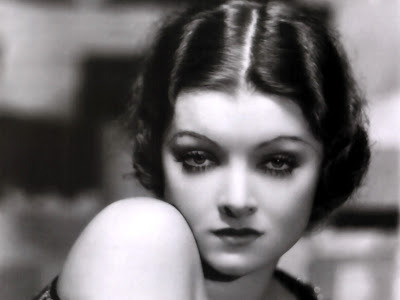
Myrna Loy: "Thirteen Women," "The Mask of Fu Manchu," "The Thin Man," "Manhattan Melodrama," "Night Flight"
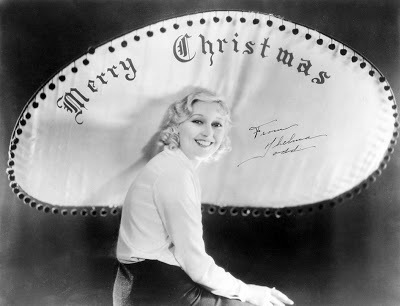
Thelma Todd: "Monkey Business," "Horse Feathers," "Hips Hips Hooray," "The Maltese Falcon" (1931 version) plus dozens of shorts both in supporting roles (with Laurel and Hardy) and leads
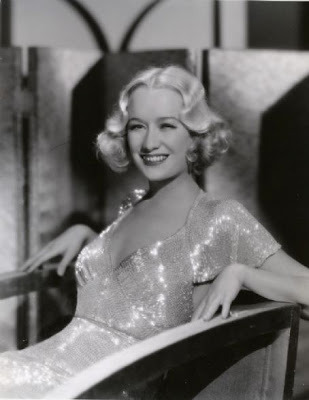
Miriam Hopkins: "Dr. Jekyll and Mr. Hyde" (1931 version), "The Story of Temple Drake," "Design for Living"

Joan Blondell: "The Public Enemy," "Night Nurse," "Gold Diggers of 1933," "Footlight Parade," "Blondie Johnson," "Havana Widows," "Three on a Match," "The Crowd Roars," "Other Men's Women," "Lawyer Man," "Blonde Crazy." (Queen of the Pre-Codes, as far as I'm concerned -- and a pretty impressive career after the Code, too.)

Ann Dvorak: "Scarface," "Three on a Match," "The Strange Love of Molly Louvain," Side Streets," "Massacre," "The Crowd Roars"

Aline MacMahon: "Five Star Final," "Side Streets," "Gold Diggers of 1933," "The Mouthpiece," "Heroes for Sale"

Barbara Stanwyck: "Night Nurse," "Ladies They Talk About," "Baby Face," "Ten Cents a Dance"

Mae Clarke: "Night World," "The Public Enemy," "Frankenstein," "Waterloo Bridge," "Fast Workers," "The Man With Two Faces," "Turn Back the Clock"

Marion Marsh: "Five Star Final," "Under 18," "Beauty and the Boss" (She's also in a great Josef Von Sternberg version of "Crime and Punishment" that, being released in 1935, just misses the Pre-Code era. Look for a review sometime around June 1, in this blog's monthly movie recap.)

Leila Hyams: "Freaks," "Isle of Lost Souls" (I've only seen her in those two movies, but c'mon -- as taboo-breaking horror movies go, that's a hell of a pair to draw to.)

Myrna Loy: "Thirteen Women," "The Mask of Fu Manchu," "The Thin Man," "Manhattan Melodrama," "Night Flight"

Thelma Todd: "Monkey Business," "Horse Feathers," "Hips Hips Hooray," "The Maltese Falcon" (1931 version) plus dozens of shorts both in supporting roles (with Laurel and Hardy) and leads

Miriam Hopkins: "Dr. Jekyll and Mr. Hyde" (1931 version), "The Story of Temple Drake," "Design for Living"
Published on May 17, 2013 20:18
Will Pfeifer's Blog
- Will Pfeifer's profile
- 23 followers
Will Pfeifer isn't a Goodreads Author
(yet),
but they
do have a blog,
so here are some recent posts imported from
their feed.



